 |
 |
 |
| |
Vision Impairment More Frequent in Older HIV+ Men--With Functional Consequences
|
| |
| |
10th IAS Conference on HIV Science (IAS 2019), July 21-24, 2019, Mexico City
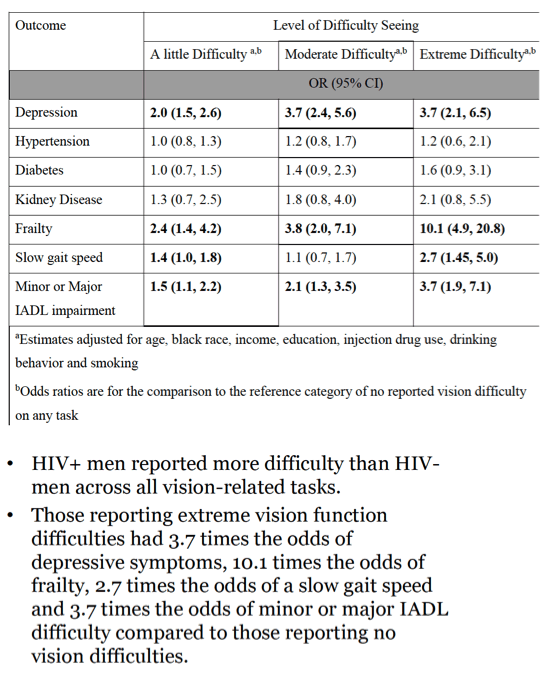
Mark Mascolini
Older US men with HIV reported impaired vision more often than age-matched men without HIV across 6 vision-related tasks [1]. In 634 age-matched HIV+/HIV- pairs, even a little vision impairment independently predicted depression, frailty, slow gait, and minor or major impairment in instrumental activities of daily living (IADL).
Worsening vision can be expected in an aging population with HIV infection. Yet few studies have assessed prevalence and consequences of impaired vision in HIV-positive people. Researchers working with the Multicenter AIDS Cohort Study (MACS), an ongoing observational study of men with HIV and similar HIV-negative men, compared vision impairment in these two populations.
Men eligible for this analysis completed a questionnaire on vision function from September 2017 to March 2018. They rated difficulty of 6 vision-dependent tasks as none, a little, moderate, and extreme. Researchers assessed frailty by Fried frailty criteria, IADL by the Lawton-Brody IADL Questionnaire, and depression by the Center for Epidemiologic Studies Depression Scale (CES-D).
The analysis involved 634 age-matched HIV+/HIV- pairs. Median age stood at 60.4 years in both groups. Compared with HIV-positive men, those without HIV had a lower proportion of blacks (20.5% versus 27.0%), a lower proportion with income below $30,000 (31.0% versus 44.9%), a lower proportion with an injection drug use history (0.9% versus 2.4%), and lower proportions with depression (30.8% versus 37.5%), hypertension (55.8% versus 61.7%), or diabetes (15.5% versus 23.6%) (P < 0.05 for all).
Compared with HIV-negative men, those with HIV reported higher prevalence of at least a little difficulty in all 6 vision tasks tested: reading print, doing hobbies, going up steps, finding things, noticing objects, and driving.
Logistic regression analysis adjusted for age, black race, income, education, injection drug use, drinking behavior, and smoking linked a little difficulty seeing (versus no difficulty) with depression (odds ratio [OR] 2.0, 95% confidence interval [CI] 1.5 to 2.6), frailty (OR 2.4, 95% CI 1.4 to 4.2), slow gait speed (OR 1.4, 95% CI 1.0 to 1.8), and minor or major IADL impairment (OR 1.5, 95% CI 1.1, to 2.2). Moderate difficulty seeing (versus no difficulty) predicted depression (OR 3.7, 95% CI 2.4 to 5.6), frailty (OR 3.8, 95% CI 2.0 to 7.1), and minor or major IADL impairment (OR 2.1, 95% CI 1.3 to 3.5). Extreme difficulty seeing (versus no difficulty) predicted depression (OR 3.7, 95% CI 2.1 to 6.5), frailty (OR 10.1, 95% CI 4.9 to 20.8), slow gait speed (OR 2.7, 95% CI 1.45 to 5.0), and minor or major IADL impairment (OR 3.7, 95% CI 1.9 to 7.1).
The MACS team concluded that older men with HIV bear a larger burden of difficulty with vision-related tasks than age-matched men without HIV. Furthermore, "vision difficulty is related to mental health and physical function consequences with stronger associations among HIV+" men.
Reference
1. Abraham AG, Ervin A, Swenor B, et al. The physical and mental health implications of vision impairment in aging HIV-infected men. 10th IAS Conference on HIV Science (IAS 2019), July 21-24, 2019, Mexico City. Abstract TUPEB214. For e-poster:
https://programme.ias2019.org//PAGMaterial/eposters/2217.pdf
——————————————
SOCA DISCONTINUED, With Aging Population, WE NEED TO follow vision & eye deterioration in aging older HIV+. Jules
About Studies of Ocular Complications of AIDS (SOCA)
The Studies of Ocular Complications of AIDS (SOCA) is a collaborative multicenter research effort whose objective is to evaluate strategies for the treatment and prevention of ocular complications associated with AIDS. SOCA focuses its efforts on cytomegalovirus (CMV) retinitis, as it is the most common ocular opportunistic complication of AIDS. CMV retinitis progressively destroys retinal tissue resulting in vision loss. Early treatments slowed progression and in some cases stopped it. Complex treatment regimens as well as viral resistance have complicated treatment and adversely affected quality of life. Hence, SOCAs goal is to evaluate new treatments and test therapeutic strategies for CMV retinitis in the hope of prolonging remission periods and preserving vision without decreasing the length or quality of life. The SOCA research group is committed to developing standards and new methodologies for clinical trials and long term epidemiological investigations of the progression and outcome of ocular complications of AIDS.
SOCA began in 1989 through funding from the National Eye Institute, started enrollment of patients in March of 1990, and completed five clinical trials and a prospective observational cohort study. The SOCA clinical trials were conducted over a nine year period (1989 through 1998), and were designed to examine the effects of current and emerging treatments for cytomegalovirus retinitis in people with AIDS. The treatment strategies are summarized in the Design Tables of the SOCA Curriculum Vitae (CV) located on the SOCA webpage: https://jhuccs1.us/soca/lsoca/open/investinfo.htm.
From 1998 through 2013, the Longitudinal Studies of Ocular Complications of AIDS (LSOCA), a long term prospective epidemiological study was designed in the first 10 years to 1) monitor secular trends in the incidence of CMV retinitis and other complications of AIDS, 2) determine the effect of highly active anti-retroviral treatments, or HAART-induced changes in immune status on the risk of CMV retinitis and other complications of AIDS, 3) determine the characteristics (clinical, virologic, hematologic, and biochemical) of populations at high risk for CMV retinitis and other complications of AIDS, and 4) evaluate the effects of treatment for CMV retinitis and other ocular complications on visual function, quality of life and survival. During the final 6 years (2008 to 2013) the objectives were to evaluate 1) long term outcomes of ocular opportunistic infections (OOIs) among patients with AIDS; 2) visual impairment among patients with AIDS and without OOIs (No OOIs), and 3) host genetic risk factors and immunologic mechanisms of these ocular complications and their outcomes.
----------------------
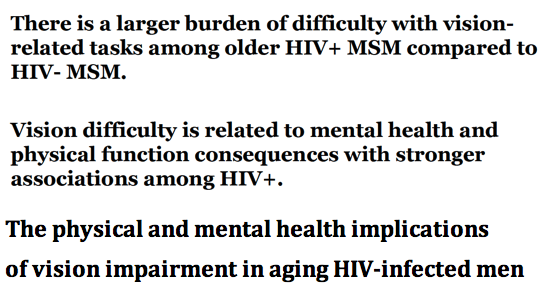
Alison G Abraham, Ann Ervin, Bonnie Swenor, Pradeep Ramulu, Roomasa Channa, Xiangrong Kong, Michael Plankey
Department of Epidemiology, Johns Hopkins Bloomberg School of Public Health, Baltimore, MD; Department of Medicine, Division of Infectious Diseases, Georgetown University, Washington DC; Department of Ophthalmology, Johns Hopkins School of Medicine, Baltimore, MD
Background: There are few studies of ocular disease and visual impairment among aging HIV-infected adults in the modern therapy era. This study used data from the Multicenter AIDS Cohort Study (MACS), an aging cohort of HIV-infected and -uninfected men who have sex with men (MSM) to describe the burden of vision impairment and its physical and mental health correlates.
Methods: A modified version of the National Eye Institute vision function questionnaire was administered to assess the level of difficulty performing vision-dependent tasks (no difficulty, some difficulty, moderate difficulty, and extreme difficulty). Among participants who answered at least one question on visual function from September 2017 to March 2018, we matched HIV-infected to -uninfected on exact year of age and imputed missing covariate data using 20 imputation data sets. Prevalences of vision problems were estimated by HIV-serostatus, and the relationships of self-reported visual functioning difficulties with physical and comorbidity outcomes were examined using logistic regression, regressing each outcome separately on visual function as indicator variables with no difficulty used as the reference.
Results: There were 634 age-matched pairs for a total sample size of 1268 out of 1700 with available data. The median age was 60 years (IQR: 54.3, 65.9) and 24% were African American. Among HIV-infected men (93%) were virally suppressed. Overall, there were 51 reported eye conditions with the most prevalent being cataract (25% of the reported diagnoses). HIV-infected men reported more difficulty than HIV-uninfected men across all vision-related tasks. Those reporting modest or extreme visual difficulties had 3.7 times the odds of depression, 10.1 times the odds of frailty (consistent with the Fried definition), 2.7 times the odds of a slow gait speed (present if time to walk 4 m is more than 80th percentile of HIV− men and 3.7 times the odds of minor or major IADL difficulty (using the Lawton-Brody Instrumental Activities of Daily Living Questionnaire) compared to those reporting no visual difficulties.
Conclusions: There was a higher prevalence of difficulty with vision-related tasks with a larger burden of mental health and physical function consequences among older HIV-infected MSM compared to HIV-uninfected men.
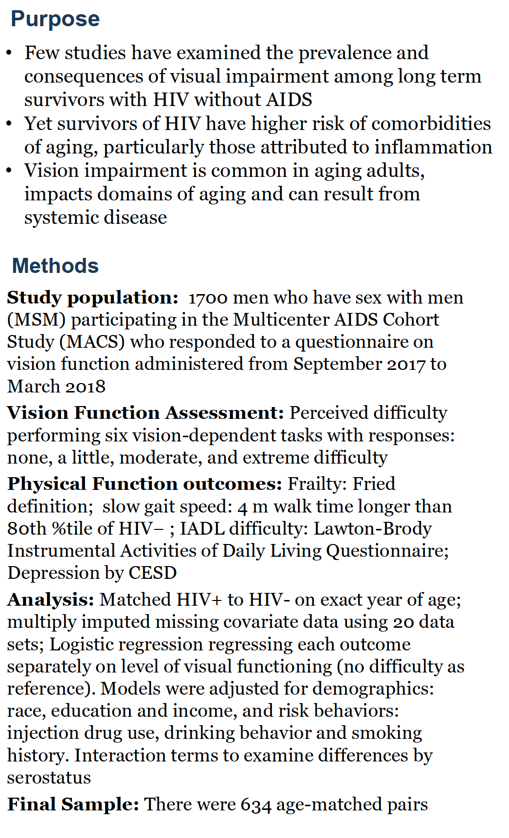
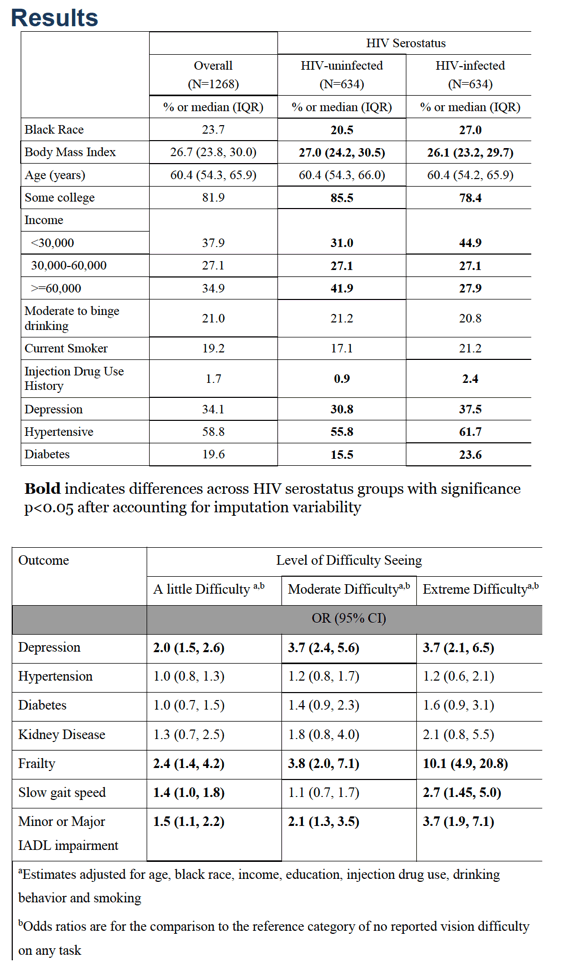

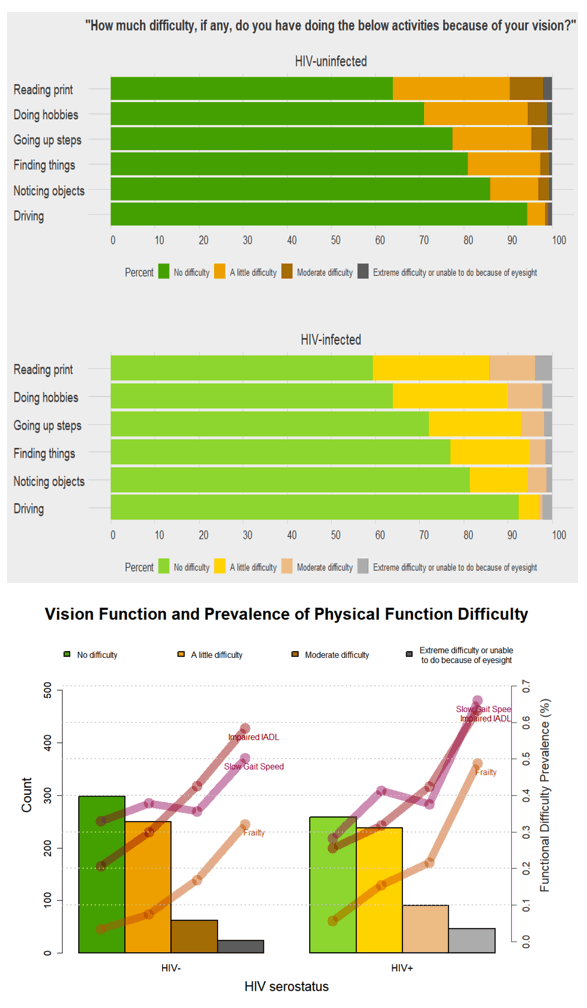

|
| |
|
 |
 |
|
|